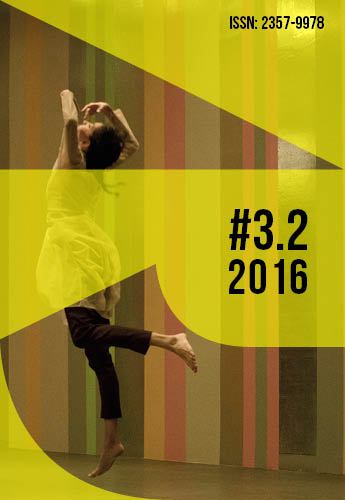Ressonância na dança: A arte de mesclar corpos
DOI:
https://doi.org/10.36025/arj.v3i2.10755Palavras-chave:
Dança, Cognição, Correspondência eu-outro, Mesclagem conceitualResumo
Na dança, “ressonância” descreve um sentido compartilhado de energia, ritmo, fluência e coerência. Coreógrafos e dançarinos buscam ressonância para criar e dançar. Teorizo que a ressonância é um tipo de cognição social humana no contexto da correspondência eu-outro, definida como qualquer fenômeno no qual a observação do comportamento ou estado do outro leva o comportamento ou estado do observador a se tornar congruente com o primeiro. Realizo uma revisão dos achados da cognição e das neurociências para mostrar que “ressonância na dança” é uma mesclagem de sentimento e conhecimento que se originam dos sistemas “de reflexo” somatomotores que preparam processos mais reflexivos como a aprendizagem por imitação, a tomada de perspectiva e a empatia. Introduzo a hipótese da “mesclagem conceitual corporificada” como um mecanismo para ressonância na dança. Exploro questões que se originam sobre o papel e a função da ressonância na dança e discuto sobre questões de gênero e implicações.
Tradução: Mônica Medeiros Ribeiro e Thais Torres Guimarães
Downloads
Referências
BLAIR, Rhonda. Cognitive neuroscience and acting: Imagination, conceptual blending, and empathy. TDR/The Drama Review vol. 53, no. 4, p. 93-13, 2009.
BLÄSING, Bettina, PUTTKE, Martin, and SCHACK, Thomas (Eds.). The Neurocognition of Dance: Mind, movement and motor skills. New York: Psychology Press, 2010.
BONINI, Luca, ROZZI, Stefano, SERVENTI, Francesca U., SIMONE, Luciano, FERRARI, Pier F., and FOGASSI, Leonardo. Ventral premotor and inferior parietal cortices make distinct contribution to action organization and intention understanding. Cerebral Cortex v. 20, p. 1372-1385, 2009.
BROWN, Steven, MARTINEZ, Michael J., and PARSONS, Lawrence M. The neural basis of human dance. Cerebral Cortex vol. 16, no. 8, p. 1157-1167, 2006.
BUTLER, Judith. Performative acts and gender constitution: An essay in phenomenology and feminist theory. Theatre Journal v. 40, n. 4, p. 519-531, 1988.
CHAFFIN, Roger, LOGAN, Topher R., and BEGOSH, Kristen T. Performing from memory. In HALLAM, Susan, CROSS, Ian, and THAUT, Michael (Eds.). Oxford Handbook of Music Psychology. Oxford, UK: Oxford University Press, 2008, p. 352-363.
CHARTRAND, Tanya L., and BARGH, John A. The chameleon effect: The perception–behavior link and social interaction. Journal of Personality and Social Psychology vol. 76, no. 6, p. 893-910, 1999.
CSIKSZENTMIHALY, Mihaly. Flow and the Psychology of Discovery and Invention. New York: Harper Collins, 1996.
DAMASIO, Antonio, R. The Feeling of What Happens: Body and emotion in the making of consciousness. New York: Houghton Mifflin Harcourt, 1999.
DeWAAL, Frans B., and FERRARI, Pier F. Towards a bottom-up perspective on animal and human cognition. Trends in Cognitive Science v. 14, n. 5, p. 201–207, 2010.
EISENBERG, Nancy, and STRAYER, Jane (Eds.). Empathy and Its Development. Cambridge, England: Cambridge University Press, 1987.
EMERY, Nathan. J., LORINCZ, Erica N., PERRETT, David I., ORAM, Michael W., and BAKER, Christopher I. Gaze following and joint attention in rhesus monkeys. Journal of Comparative Psychology v. 111, n. 3, p. 286–293, 1997.
EVANS, Jonathan S. Dual-processing accounts of reasoning, judgment, and social cognition. Annual Review of Psychology v. 59, p. 255–278, 2008.
FACCHINETTI, Lívia D., IMBIRIBA, Luis A., AZEVEDO, Tatiana M., VARGAS, Claudia D., and VOLCHAN, Eliane. Postural modulation induced by pictures depicting prosocial or dangerous contexts. Neuroscience Letters v. 410, no. 1, p. 52-56, 2006.
FAUCONNIER, Gilles, and TURNER, Mark. The Way We Think: Conceptual Blending and the Mind’s Hidden Complexities. New York: Perseus Books Group, 2002.
FAUCONNIER, Gilles. Compression and emergent structure. Language and Linguistics v. 6, no. 4, p. 523-38, 2005.
GALLESE, Vittorio, and LAKOFF, George. The Brain's Concepts: The Role of the Sensory-Motor System in Conceptual Knowledge. Cognitive Neuropsychology vol. 22, no. 3-4, p. 455-479, 2005.
GENANGU, Elena, BENGA, Oana, STAHL, Daniel, and STRIANO, Tricia. Contagious crying beyond the first days of life. Infant Behavior and Development vol. 33, no. 3, p. 279-288, 2010.
GOODALL, Jane. The Chimpanzees of Gombe: Patterns of behavior. Cambridge, MA: Harvard University Press, 1986.
HARRISON, Neil A., WILSON, C. Ellie, and CRITCHLEY, Hugo D. Processing of observed pupil size modulates perception of sadness and predicts empathy. Emotion vol. 7, no. 4, p. 724-729, 2007.
HOGAN, Robert. Development of an empathy scale. Journal of Consulting and Clinical Psychology vol. 33, no. 3, p. 307-316, 1967.
HOLLIN, Clive. Forensic (criminological) psychology. In COLMAN, Andrew (Ed.). Companion Encyclopedia of Psychology. London: Routledge, 1994, p. 1231-1253
JEANNEROD, Marc, and FRAK, Victor. Mental imaging of motor activity in humans. Current Opinion in Neurobiology vol. 9, no. 6, p. 735–739, 1999.
KAUFMAN, James C., and STERNBERG, Robert J. (Eds.). The Cambridge Handbook of Creativity. New York: Cambridge University Press, 2010.
KIRSH, David. Thinking with the body. In OHLSSON, Stellan, and CATRAMBONE, Richard (Eds.). Proceedings of the 32nd Annual Meeting of the Cognitive Science Society. Austin, TX: Cognitive Science Society, p. 2864-2869, 2010.
McNEILL, William H. Keeping Together in Time: Dance and drill in human history. Cambridge, MA: Harvard University Press, 1997.
MELTZOFF, Andrew N., and MOORE, M. Keith. Imitation of facial and manual gestures by human neonates. Science vol. 198, no. 4312, p. 75–78, 1977.
NEAL, David T., and CHARTRAND, Tanya L. Embodied emotion perception amplifying and dampening facial feedback modulates emotion perception accuracy. Social Psychological and Personality Science vol. 2, no. 6, p. 673-678, 2011.
PLUTCHIK, Robert. Evolutionary bases of empathy. In EISENBERG, Nancy, and STRAYER, Jane (Eds.). Empathy and Its Development. Cambridge, England: Cambridge University Press, 1987, p. 38-46.
PREMACK, David, and WOODRUFF, Guy. Does the chimpanzee have a theory of mind? Behavioral and Brain Sciences vol. 1, no. 4, p. 515-526, 1978.
PRESTON, Stephanie D., and DeWAAL, Frans B. Empathy: Its ultimate and proximate bases. Behavioral and Brain Sciences vol. 25, no. 1, p. 1-20, 2002.
RIBEIRO, Mônica M., LIMA, Isabela, MALLOY-DINIZ, Leandro, LAGE, Guilherme, PIMENTEL, Lucia G., and TEIXEIRA, Antônio L. Corporal Artistic Training Influences Attention: A Pilot Study. Perceptual and Motor Skills vol. 118, no. 3, p. 818-832, 2014.
SHEETS-JOHNSTONE, Maxine. The Corporeal Turn: An interdisciplinary reader. Exeter, UK: Imprint Academic, 2009.
STEVENS, Catherine, and McKECHNIE, Shirley. Thinking in action: thought made visible in contemporary dance. Cognitive Processing vol. 6, no. 4, p. 243-252, 2005.
VARELA, Francisco J., THOMPSON, Evan, and ROSCH, Eleanor. The Embodied Mind: Cognitive science and human experience. Cambridge, MA: The MIT Press, 1991.
WARBURTON, Edward C. Of meanings and movements: Re-languaging embodiment in dance phenomenology and cognition. Dance Research Journal vol. 43, no. 2, p. 65-84, 2011.
WARBURTON, Edward C., WILSON, Margaret, LYNCH, Molly, and CUYKENDALL, Shannon. The cognitive benefits of movement reduction: Evidence from dance marking. Psychological Science vol. 24, no. 9, p. 1732-1739, 2013.
WHITEN, Andrew, MCGUIGAN, Nicola, MARSHALL-PESCINI, Sarah, and HOPPER, Lydia M. Emulation, imitation, over-imitation and the scope of culture for child and chimpanzee. Philosophical Transactions of the Royal Society of London B: Biological Sciences vol. 364, no. 1528, p. 2417-2428, 2009.
ZENTALL,Thomas R. Imitation: definitions, evidence, and mechanisms. Animal cognition vol. 9, no. 4, p. 335-353, 2006.
Downloads
Publicado
Como Citar
Edição
Seção
Licença
Copyright (c) 2016 Edward C. Warburton (Autor)

Este trabalho está licenciado sob uma licença Creative Commons Attribution-NonCommercial-ShareAlike 4.0 International License.

Esta obra está licenciada com uma Licença Creative Commons Atribuição-NãoComercial-CompartilhaIgual 4.0 Internacional.
Autores detêm os direitos autorais ao licenciar sua produção sob Creative Commons Atribuição-NãoComercial-CompartilhaIgual 4.0 Internacional.


 English
English Português (Brasil)
Português (Brasil)
